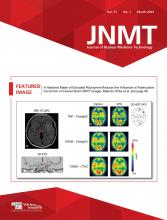Abstract
68Ga-DOTATATE PET/CT is an important imaging modality for detection of culprit lesions of tumor-induced osteomalacia in clinically symptomatic patients with hypophosphatemia–osteomalacia. Somatostatin receptor expression may at times be observed in inflammatory or granulomatous conditions and in fractures or degenerative bone disease, leading to false-positive scan findings. We present a rare case of hereditary hypophosphatemia–osteomalacia that showed increased false-positive uptake (for possible tumor-induced osteomalacia lesions) in an inflammatory condition of the maxillary sinus and a fracture of the tibia on somatostatin receptor–based 68Ga-DOTATATE PET/CT.
In tumor-induced osteomalacia (TIO), the culprit lesions are usually mesenchymal tumors with somatostatin receptor (SSTR) expression, and 68Ga-DOTATATE PET/CT plays an important role in tumor localization and management. We present a rare case of hereditary hypophosphatemia–osteomalacia that showed false-positive foci on 68Ga-DOTATATE PET/CT mimicking possible TIO lesions.
CASE REPORT
In a 45-y-old man with bony pain in the chest wall, back, and lower limbs of 1.5-y duration, multiple old healed rib fractures were found, and blood work revealed a low level of serum phosphorus (2.1 mg/dL), a raised level of serum alkaline phosphatase (208 IU/L), and a markedly raised level of fibroblast growth factor 23 (FGF-23) (1,561.5 relative units/mL). The clinical features, low level of serum phosphorus, and raised level of FGF-23 were highly suggestive of TIO. The patient underwent 68Ga-DOTATATE PET/CT for detection of the culprit lesion of TIO. Whole-body PET/CT was performed on a Philips Gemini TF time-of-flight 16 PET/CT scanner 60 min after intravenous injection of 74 MBq (2 mCi) of 68Ga-DOTATATE. Images were acquired using a 3-dimensional PET protocol at 3 min per bed position. Data were reconstructed using an iterative algorithm (row-action maximum likelihood: 2 iterations and 21 subsets). Non–contrast-enhanced, low-dose CT (voltage, 120 kVp; slice thickness, 5 mm; pitch, 0.83; field of view, 600 mm; rotation time, 0.5 s; 50 mA) was used for anatomic localization and attenuation correction of PET data. Maximum-intensity-projection PET (Fig. 1A) showed abnormal SSTR uptake in the maxillary sinus and knee region. Transaxial PET/CT (Fig. 1B) showed mildly increased SSTR uptake (SUVmax, 5.42) in the left maxillary sinus, with mucosal thickening. Coronal PET/CT (Fig. 1D) showed mild SSTR uptake (SUVmax, 3.84 on right) and faint SSTR uptake (SUVmax, 2.3 on left) in a sclerotic lesion in the medial part of the upper condyle of tibia, bilaterally (right > left side). These findings were suggestive of culprit lesions of TIO. In view of the doubtful findings on 68Ga-DOTATATE PET/CT, multiplanar MRI of the paranasal sinus and knee was performed using spin-echo T1-weighted, fast spin-echo T2-weighted, turbo inversion-recovery magnitude, and short-tau inversion-recovery sequences. MRI of the maxillary sinus (Fig. 1C) showed moderate T2 hyperintense mucosal thickening in the left maxillary sinus, with central T2 hypointense areas due to retained secretion. MRI of the knee (Fig. 1E) showed a fracture along the proximal inner medial part of the left and right tibiae on a T1-weighted coronal view, with mild periosteal edema. The MRI findings were suggestive of benign disease in both regions. Subsequently, the patient was evaluated for hereditary hypophosphatemia. The SLC2A2 (−) phenotype was identified, which is pathogenic for the autosomal recessive disorder Fanconi–Bickel syndrome.
(A) Maximum-intensity-projection 68Ga-DOTATATE PET image showing abnormal SSTR uptake in maxillary sinus (green arrow) and knee (red arrow) regions. (B and D) Transaxial 68Ga-DOTATATE PET/CT image showing mildly increased uptake (arrow, SUV max of 5.42) in left maxillary sinus, with mucosal thickening (B), and coronal 68Ga-DOTATATE PET/CT image showing mildly SSTR-avid sclerotic lesion (arrow, SUVmax of 3.84) in medial part of upper condyle of right tibia and faint SSTR uptake in medial part of upper condyle of left tibia (D). (C and E) MRI of maxillary sinus showing moderate T2 hyperintense mucosal thickening in left maxillary sinus, with central T2 hypointense areas due to retained secretion (C, arrow), and MRI with T1-weighted coronal view of knee showing fracture along proximal inner medial part of left and right tibiae (E, arrow), both of which were suggestive of benign etiologies.
DISCUSSION
68Ga-DOTATATE PET/CT is an important noninvasive imaging modality for detection and localization of the culprit lesion of TIO. Other than in tumors, SSTR expression is observed in inflammatory or granulomatous conditions and in fractures or degenerative bone disease, leading to false-positive scan findings in various oncologic cases (1–4). A raised level of FGF-23 is not specific to TIO and can also be found in hereditary hypophosphatemia- and osteomalacia-inducing musculoskeletal disorders, such as X-linked hypophosphatemic rickets and autosomal dominant and recessive hypophosphatemic rickets (5). Our patient presented with long-standing systemic symptoms of hypophosphatemia, with a raised level of FGF-23. 68Ga-DOTATATE PET/CT was considered to localize the culprit lesion of TIO in view of the clinically symptomatic and biochemically proven case of hypophosphatemia with an increased FGF-23 level. Increased SSTR uptake was seen in the maxillary sinus and bilaterally in the tibial regions, which on MRI were illustrative of benign etiopathologies. Finally, the patient was diagnosed with hereditary hypophosphatemia caused by the autosomal recessive disorder Fanconi–Bickel syndrome.
CONCLUSION
68Ga-DOTATATE PET/CT is used as the first-line imaging modality in suspected cases of TIO. In addition to being found in TIO, a raised FGF-23 level can also be found in other hypophosphatemia- and osteomalacia-inducing musculoskeletal disorders. However, SSTR uptake is also seen in inflammatory or granulomatous conditions and in fractures or degenerative bone disease. This should be kept in mind when one is interpreting 68Ga-DOTATATE PET/CT images with equivocal or doubtful findings in hypophosphatemia–osteomalacia cases.
DISCLOSURE
No potential conflict of interest relevant to this article was reported.
Footnotes
Published online Feb. 23, 2022.
REFERENCES
- Received for publication December 30, 2021.
- Revision received January 28, 2022.








